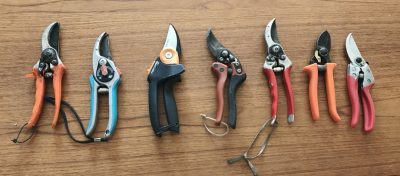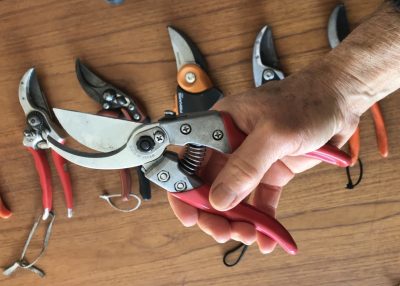Shears Galore
For Those Smaller Cuts
What gardener doesn’t need to prune some thing at some time? In many cases, a thumbnail suffices, as when pinching out the growing tip of a marigold or basil plant to make it grow more bushy. Or pinching off the soft green tip of a young apple shoot to temporarily stall its growth and let the leader, destined (by you) to be the future trunk and main limb, to remain top dog. Your thumbnail, though, isn’t always sufficiently long to use as a pruning tool, or else stems have toughened up beyond your thumbnail’s capabilities.
When more than your thumbnail is needed, there are many pruning tools from which to choose. If you’re going to own but one pruning tool, that tool should probably be a pair of hand shears, which are useful for cutting stems up to about 1/2” across.
As with everything these days from cold cereals to corn chips to soaps, a wide, confusing array confronts you whether in a catalog, the web, or a store shelf. Having written a book about all aspects of pruning, inc

Bypass blade (left) vs anvil blade (right)
luding the tools of the trade (The Pruning Book), I’ve been afforded the opportunity to try out a slew of pruning shears. Looking for a pair to buy? I’m going to make it easier for you
Okay, okay, personal taste does come into play here. That’s why the ideal is to be able to fondle a candidate before purchase or, even better, try it out. Still, some general design features are important to function.
The blades, for instance. Blade configurations fall into one of two categories: anvil and bypass (the latter sometimes called “scissors”). The business end of the anvil-type shears consists of a sharp blade that comes down on top of an opposing blade having a flat edge. The flat edge is made of plastic or a soft metal so as not to dull the sharp edge. Bypass pruners work more like scissors, with two sharpened blades sliding past each other.
Anvil shears generally are cheaper than bypass shears — and the price difference is reflected in the resulting cut! Unless the single, sharp blade is kept truly sharp, the anvil pruner will crush part of the stem. And if the two blades do not mate perfectly, the cut will be incomplete, leaving the two pieces of the stem attached by threads of tissue. That wide, flattened blade also makes it more difficult to get the tool right up against the base of the stem you want to remove.
The blades of some bypass shears are hooked at their ends to help prevent stems from slipping free of the jaws as you cut. Other shears achieve the same effect with a rolling action of one bypass blade along the other as the handle is squeezed.Beyond blade design, certain special features found on some pruning shears might appeal to you personally. Some shears are tailored to fit left hands or small hands, although on some of the latter the effect is achieved by merely shrinking the maximum blade opening when adjusted to the smaller hand size.
To make it easier to slice through thick stems, some shears have a ratchet action; weigh the virtue of more power against the need for repeatedly squeezing the handles for each cut. Other shears (allegedly) ease hand strain by having models with hand grips that rotate as you make the cut and/or varying the angle of the blades in relation to the handles.
And My Favorite Pruning Shear Is . . .
I have a collection of pruning shears and they all hang on the wall near the back door. A good test of how I actually feel about a particular pruning shear is how frequently I grab it as I go out the door.
I have narrowed down my favorites to three, which are . . . ‘rat-a-tat-tat’ drum roll. Well, it depends on what I’m pruning. If it’s just light pruning, I generally reach for my Pica shears, a model that should be better known. They’re light but sturdy, and their blades are hooked at their ends to (I guess) help prevent stems from slipping free of the jaws as you cut.
For the heaviest cuts I’d make with a hand shears, I reach for my Felco No. 7, universally recognized as great shears by those in the know. It has a nice feel, although a little topheavy, and the blades are of high quality steel and are replaceable, as are most parts.
My favorite all-around shear, the one I’d get if I could own only one shear (shudder the thought!), is my ARS VS-8 pruner.
Not a catchy name, but a top notch pruner with good weight, good steel, replaceable parts, and — my favorite part — easily opened with just a firm squeeze of the handles.
So there they are, my recommendations. Consider these before making an impulse purchase for whatever shear happens to be staring you in the face.


